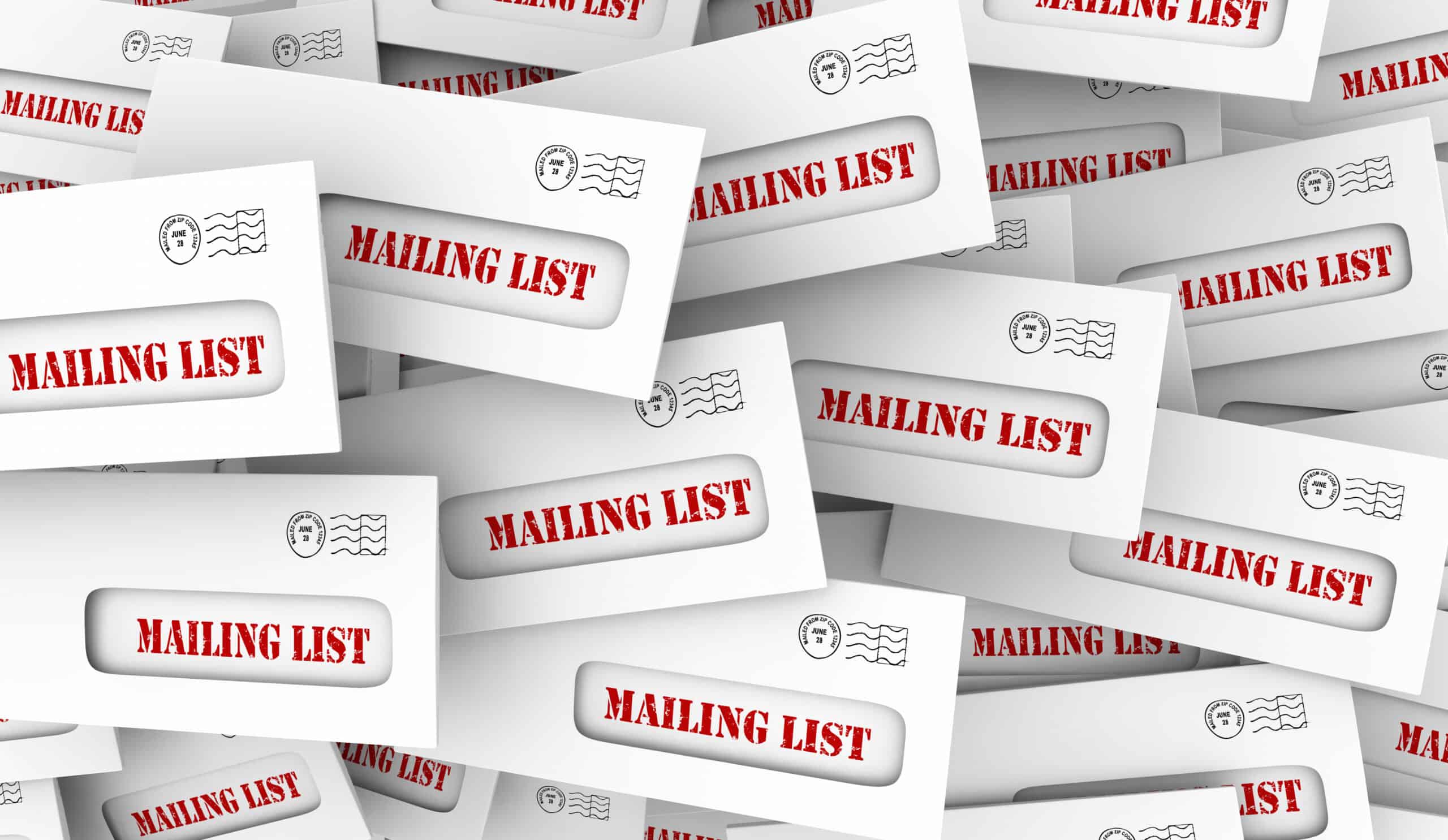
Keeping your mailing list up to date is essential for making the most of your marketing dollars. It ensures that your messages arrive in a timely fashion and provides other benefits such as cost savings and better targeting. Let’s look at five benefits of an up-to-date mailing list to motivate you to make this one of your top investments.
1. Gives you a strong foundation. Accurate, up-to-date lists are the starting point for creating relevant, personalized communications. Keeping your mailing list clean, accurate, de-duped, and up to date is a best practice that should be part of your routine. If you get in the habit of keeping up with the basics, it will help you with more sophisticated targeting later.
2. Keep customers happy. Nothing says, “We don’t care,” like a misspelled name or street address. Sure, your mailer might get there (eventually), but at what cost? Keeping your list up to date ensures that your target audience knows you care enough to get it right.
3. Keeps costs down. With an inaccurate list, you are printing and mailing pieces that may never arrive. Don’t waste money! Ensure that every piece gets to its destination. With an accurate list, you also save money by not sending duplicates to the same individual or household.
4. Provides anchor points. As you compile your records, basic data points can be used as reference points for future refinement and additions to that list. For instance, is Jane C. Cochran the same person as Jane Cochran? Can Bob Smith be distinguished from Robert Smith, Jr.? These questions can be answered by cross-referencing data points from an accurate mailing list.
5. Improves targeting. Once you are confident in your list, you can begin to build more detailed profiles of each person. You can purchase additional data to construct more complete profiles that will help you improve your targeting and personalize your communications even more.
Invest in your mailing list regularly. Not only does it help you create an accurate, up-to-date profile of your customers that improves targeting and saves money, but because your email, social, and mobile marketing all draw off the same list, it also benefits your marketing in other channels.

You come home from work and discover that you received a direct mail piece. Nice! We all love mail. But then you talk to your neighbor, and they got the same piece in their mailbox. Then you talk to another neighbor, and they got one, too. So did the neighbor across the street and the neighbor the next road over. So much for feeling special.
Personalization matters. It makes people feel valued, especially when it arrives in print. Digital personalization is all around us, from Amazon recommendations to shopping cart abandonment reminders, but personalization in print marketing is less common. It stands out.
While personalization in print stands out for relevance, it increasingly stands out for another reason: respect. What do we mean by that?
Personalizing your print communications shows respect for the recipient’s time. Nobody has time for irrelevant mail anymore. Buyers know that personalization is possible—they even expect it. They look for it, and they recognize it when they see it. By personalizing the piece, the recipient knows that you’ve taken the time to create something just for them. They know that when they open it, they are less likely to find something irrelevant that is a waste of their time.
It’s no wonder that, in a classic InfoTrends study on the value of print personalization, when consumers were asked how providers can improve the value of their direct mail communications, two of the top three responses were “make them relevant to me” (34%) and “personalize the content for me” (28%). Do you know the top reason for marketers to personalize their transactional mail, in particular? “Make it easier to understand,” with 43% giving this answer. This, again, shows respect for the recipient’s time.
It’s no wonder that when asked how personalization affected the amount of time consumers spent with marketing mail, nearly half (49%) agreed that they spend “much more time” reading direct mail that is “personalized and relevant” to them than they do with generic direct mail.
The data continue to tell the story. You’re missing a massive opportunity if you’re not personalizing your print or digital communications. Need to get started? Let’s do it!

Targeting is the foundation of any highly effective marketing campaign, but there are different ways to slice and dice your list based on your marketing goals. Here are four different ways to target your audience. Which approach might work best for your next marketing campaign?
1. Demographics.
Demographics such as age, gender, ethnicity, and household income are simple but effective to focus your messaging. For example, if you are selling jewelry, you might show different collections to different recipients based on household income. If you sell automobiles, you’ll select other vehicles for those just out of college versus those married with young children.
2. Lifestyle.
Lifestyle data pools target audiences based on shared interests, such as fitness and wellness, green living, or pet ownership. Two people who look very different demographically may both love dogs or snowboarding. There are many ways to get at lifestyle data, including magazine subscriptions and past purchases.
3. Life stages data.
Whether young or old, rich or poor, we face common life stages. For example, new parents deal with diapers, and recent college graduates need to furnish apartments. Retirees may be looking to downsize, travel, or invest in a lasting legacy. Targeting based on life stage is different from targeting based on age or generation in that two shoppers might be the same age but at very different stages in life. For example, one might still be single and living at home, while another might be married and with young children. Even though they are the same age, their needs and priorities will differ.
4. Past purchases.
We can infer a lot about someone based on what they buy. If they just purchased a new pool, they’ll likely be in the market for pool accessories, too. If they just purchased home improvement supplies, there’s a good chance they’ll be in the market for new appliances.
Want to learn more about any of these data types and how to develop campaigns around them? Let us jump in and help.

Got a silo problem? If you’re like most companies doing targeted and personalized marketing, you do. You may have plenty of customer data, but it might be in different places (silos), and these places often aren’t talking to each other. As a result, your marketing is less effective than it could be.
Here are some risks to having siloed data:
- Unhappy customers. Whenever mail gets lost because you have the wrong address, whenever a mail piece arrives with a bad name, or you offer to sell a long-term customer a product they already own, you risk alienating that customer.
- High costs. The average price of every piece of returned mail is $3 (Source: Pitney Bowes). This is not just the postage and printing. It’s the cost of the piece coming back to you, figuring out what went wrong, and taking the time to fix it.
- Lost sales. How many marketing opportunities are lost because the data on customers’ preferences and behavior is siloed in different departments? That translates into lost revenue.
Let’s look at five steps for getting rid of those silos.
1. Connect inbound mail to outbound mail.
Build in tracking mechanisms that allow you to connect the incoming to outgoing mail. This can be as simple as adding a barcode unique to each participant. When the response envelope comes in, the barcode is scanned. This connects the incoming mail to the outbound file, linking the customer information together.
2. Centralize data capture.
Centralize mail processing in one location. Capture mail coming in from marketing, sales, customer service, web forms, and anywhere else in your company.
3. Extract what you need.
Your mail contains lots of essential details that can be useful to your print and digital marketing. Extract all of the insights you can, including names, addresses, channel preferences, transaction history, and customer surveys. Input it into a centralized database that can be accessed throughout the organization.
4. Look and learn.
Assign someone with a marketing and data background to analyze your database to understand what it tells you. Contained in there are critical nuggets about customer behavior, channel preferences, and more. Need help? Just ask!
5. Put it to use.
With a closed-loop on your mail communications and a centralized, up-to-date database accessible by all departments, you have a powerful marketing tool at your disposal. Take what you can learn and use it to improve your targeted and personalized direct mail marketing or other customer communications.

To create genuinely personal communications, you need to know your customers. This requires more than knowing basics like name, address, and gender. It requires knowing more about who your customers are.
Let’s take an example from the world of sports. For example, when we think of hockey fans, we might think of demographics such as age, gender, and region of the country in which a fan lives. But did you know that National Hockey League (NHL) fans are the most affluent sports fans in the country? (Out of all major league sports, the NHL has the highest percentage of fans earning more than $100,000 per year.) Or that half of Major League Baseball fans are retirees? Or that 40% of NASCAR fans are women?
The starting point for any targeted or personalized campaign is knowing the make-up of your audience. If you don’t have this information, make it one of your goals to find out. Send a direct mail or email survey or conduct a focus group. Add survey forms on your website or purchase additional data to fill in the gaps.
Don’t stop there. Ask yourself what else you might not know about your target audience that would be helpful. When the NHL started personalizing its fan communications, for example, it asked them to fill out a survey that indicated where they lived and their favorite hockey team. The NHL discovered that 40% of its fan base lives outside their favorite team’s home market. Imagine the marketing opportunities for the league!
Know your customers from the inside, too.
- Consider investing in fundamental database analysis. Identify your top 10% of customers by frequency, volume, and revenue.
- What do those customers “look” like? Create a set of customer profiles.
- What does each profile have in common (age, income, marital status, purchase habits)? In a B2B environment, you might look at the vertical market, employee size, and annual revenues.
- Get to know your bottom 10%, too. What do they look like? Are they customers you can woo back?
There is an infinite number of questions you can ask, but they all start with knowing who your customers are in the first place.

If you want to know what’s working, test it. Is this recipe better than that one? Is this pair of shoes more comfortable than those? Marketing is no different. By taking a portion of your list and testing one element at a time, you can find out what works best. Even if you’ve done testing in the past, things change. It’s essential to keep testing to make sure you know what is working now.
Unbounce, a service that allows marketers to build, publish, and test landing pages, has described the impact of testing on three different companies and the lessons learned from each. Let’s take a brief look at each one.
Test #1: Great ads can get better.
SafeSoft Solutions had a slick, professional ad that was doing well. The headline promoted productivity and efficiency. It used attention-grabbing, easy-to-read bullet points to outline the benefits of its services. But the ad did not contain pricing information. SafeSoft decided to test the addition of a green starburst with its pricing inside. The result? A 100% increase in conversions.
Test #2: Not all trial offers are created equal.
For some companies, a seven-day offer might be perfect. For others, customers might need a more extended test-out period. When HubSpot split tested its trial offer, it found that prospects required more time to make a decision. By testing a 30-day trial over a seven-day trial, it was found that it could boost conversions by 110%.
Test #3: Location matters.
Does the placement of the CTA make a difference? Inbound Strategy wanted to find out. It tweaked its site’s landing page, added more information, and played with the location of the CTA. The results? When the CTA was moved from the right-hand side of the page to the left, there was a 217% increase in conversions compared to the control.
These examples have lessons for us, as well. Whether you are working with print, email, landing pages, or any other channel, you’re missing opportunities if you’re not doing split testing regularly. What insights and higher conversion rates might you be missing?
